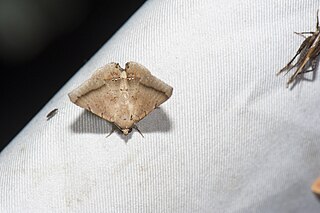Related Research Articles

Luthrodes pandava, the plains Cupid or cycad blue, is a species of lycaenid butterfly found in India, Sri Lanka, Myanmar, United Arab Emirates, Indochina, Peninsular Malaysia, Singapore, Taiwan, Java, Sumatra and the Philippines. They are among the few butterflies that breed on plants of the cycad class.

Euchrysops cnejus, the gram blue, is a small butterfly that belongs to the lycaenids or blues family. It is found from India to Australia. The species was first described by Johan Christian Fabricius in 1798.

Anthene emolus, the ciliate blue, is a small butterfly found in India and southeast Asia that belongs to the lycaenids or blues family. The species was first described by Jean-Baptiste Godart in 1823.

Thyas coronata is a species of moth of the family Noctuidae first described by Johan Christian Fabricius in 1775. It is found from the Indo-Australian tropics of southern China, Taiwan, Japan, Nepal, India, Sri Lanka to Micronesia and the Society Islands.

Macaldenia palumba is a moth of the family Noctuidae first described by Achille Guenée in 1852. It is found from the Oriental region of India, Sri Lanka to Japan (Okinawa) and Sundaland, east to New Guinea. It is also found on Guam in Micronesia.
Acronicta pruinosa is a moth of the family Noctuidae. It is found in Sri Lanka, the Himalaya, east to Japan and Taiwan south to Myanmar and Peninsular Malaysia, Borneo, Java and New Guinea.

Eutelia geyeri is a moth of the family Noctuidae first described by Rudolf Felder and Alois Friedrich Rogenhofer in 1874. This species is found in India, Sri Lanka, China and Japan, as well as from Africa, where its presence had been reported from Lesotho and Seychelles.

Callopistria latreillei, Latreille's Latin, is a moth of the family Noctuidae. The species can be found in the Palearctic realm, most parts of Europe, Asia, and in Africa from Egypt to South Africa. The habitat consists of rocky limestone slopes with deciduous woodland.
Ambia chalcichroalis is a moth in the family Crambidae. It was described by George Hampson in 1906. It is found in South Africa.
Pilocrocis pterygodia is a moth in the family Crambidae. It was described by George Hampson in 1912. It is found in Ghana, South Africa, Uganda and Zimbabwe.
Pilocrocis xanthostictalis is a moth in the family Crambidae. It was described by George Hampson in 1908. It is found in the Democratic Republic of the Congo, Madagascar and Tanzania.
Samea antisema is a moth in the family Crambidae. It was described by Edward Meyrick in 1886. It is found on Vanuatu.
Sufetula nigrescens is a moth in the family Crambidae. It was described by George Hampson in 1912. It is found in the Democratic Republic of the Congo, Ivory Coast, Madagascar, Nigeria and Sierra Leone.
Sufetula polystrialis is a moth in the family Crambidae. It was described by George Hampson in 1912. It is found on the Louisiade Islands.
Syllepte leucographalis is a moth in the family Crambidae. It was described by George Hampson in 1912. It is found in Indonesia (Bali).
Syllepte parvipuncta is a moth in the family Crambidae. It was described by George Hampson in 1912. It is found in Ghana and Sierra Leone.
Syllepte mesoleucalis is a moth in the family Crambidae. It was described by George Hampson in 1898. It is endemic to South Africa.
Tylostega tylostegalis is a moth in the family Crambidae. It was described by George Hampson in 1900. It is found in the Russian Far East and western China.
Udeoides muscosalis is a moth in the family Crambidae. It was described by George Hampson in 1913. It is found in Kenya and South Africa.
Udeoides nigribasalis is a moth in the family Crambidae. It was described by George Hampson in 1913. It is found in Kenya.
References
- ↑ Nuss, M.; et al. (2003–2014). "GlobIZ search". Global Information System on Pyraloidea. Retrieved 2014-07-15.
- ↑ De Prins, J. & De Prins, W. (2017). "Pilocrocis dichocrosialis Hampson, 1912". Afromoths. Retrieved February 28, 2018.
- ↑ The Annals and Magazine of Natural History: Including Zoology, Botany, and Geology
| This Pilocrocis-related article is a stub. You can help Wikipedia by expanding it. |